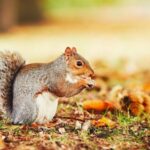Birds are known for their aerial prowess and the iconic image of a nest high in the trees. However, not all birds conform to this expectation. Many species around the world have adapted to nest on the ground, creating unique and intriguing nesting behaviors. These birds have developed specialized strategies to protect their eggs and young in the more vulnerable environment of the ground. In this article, World Of Birds will explore 7 birds who nest on the ground.
7 Fascinating Birds Who Nest on the Ground
Killdeer (Charadrius vociferus)
The Killdeer is a common ground-nesting bird that can be found across North and Central America. Part of the plover family, this bird is known for its distinctive call, which sounds like “kill-deer,” giving it its name. Killdeer typically nest in open areas, such as gravel paths, fields, and even parking lots, making them particularly visible to humans. Their nests are simple depressions in the ground, often lined with small stones or bits of vegetation.
What makes the Killdeer remarkable is its incredible defense mechanism. When a predator approaches its nest, the Killdeer performs a “broken-wing” display, pretending to be injured and luring the predator away from the eggs. Once the predator is far enough from the nest, the bird quickly flies away, leaving the predator confused and the nest safe. This clever strategy has proven highly effective in protecting its offspring from danger.
Ostrich (Struthio camelus)
As the largest bird in the world, the ostrich is also a fascinating ground-nesting species. Native to Africa, these flightless birds lay their eggs in shallow nests scraped into the ground, usually in sandy areas of the savannah or desert. Despite the simplicity of their nests, ostrich eggs are enormous, weighing up to three pounds each. A single nest can hold as many as 20 to 60 eggs, as ostriches often share communal nests with other females in their group.
The ostrich’s size offers some protection to its eggs, but their primary defense is their speed. Ostriches can run at speeds of up to 60 miles per hour (97 km/h), making them difficult targets for predators. Additionally, the male and female ostriches take turns incubating the eggs—females during the day, with their drab plumage blending into the surroundings, and males at night when their darker feathers help them stay hidden from nocturnal hunters.
Common Nighthawk (Chordeiles minor)
The Common Nighthawk is a member of the nightjar family and is well known for its ability to blend into its surroundings, thanks to its camouflaged plumage. Nighthawks nest directly on the ground in open areas such as grasslands, gravel roofs, or sandy patches. They don’t construct elaborate nests; instead, they lay their eggs in a simple depression on bare ground. The eggs are typically mottled and blend in with the surroundings, offering additional protection from predators.
Common Nighthawks are most active during dawn and dusk, hunting insects in the air. During the breeding season, the male performs impressive aerial displays to attract a mate, diving steeply through the air while producing a distinctive booming sound with its wings. This species’ ability to stay hidden during the day and active at night gives it an advantage in avoiding predators and successfully raising its young.
Piping Plover (Charadrius melodus)
The Piping Plover is a small, pale shorebird that nests along sandy beaches, gravelly shorelines, and sand dunes in North America. This species is known for its delicate, melodic calls and its highly camouflaged eggs, which blend seamlessly with the sandy environments where they nest. Piping Plovers create shallow nests known as scrapes, usually in open areas with little vegetation. These birds are particularly vulnerable to human disturbance, as they nest on popular beaches and recreational areas.
Due to habitat loss and disturbance from human activity, the Piping Plover is considered a threatened species. Conservation efforts have been implemented to protect its nesting sites, such as fencing off nesting areas and restricting access during the breeding season. Despite the challenges they face, Piping Plovers continue to use their excellent camouflage and careful nesting habits to give their young the best chance of survival.
Ruffed Grouse (Bonasa umbellus)
The Ruffed Grouse is a woodland bird native to North America, particularly known for its drumming display during mating season. This bird nests on the forest floor, typically in dense underbrush or near fallen logs, where the female builds a simple nest from leaves, twigs, and feathers. The nest is well-hidden, making it difficult for predators to spot, which is critical for a ground-nesting bird in an environment filled with potential threats.
Ruffed Grouse females rely on their excellent camouflage to protect their eggs. Their mottled brown and gray plumage allows them to blend into the forest floor, making it hard for predators to detect them while they incubate the eggs. If a predator gets too close, the female may employ distraction tactics, similar to the Killdeer, by feigning injury and luring the predator away from the nest.
Lapwing (Vanellus vanellus)
The Lapwing, also known as the Northern Lapwing or Peewit, is a striking bird native to Europe and Asia, with its distinctively long crest and green-tinged black and white plumage. Lapwings nest in open grasslands, farmlands, and marshes, where they scrape shallow depressions in the ground to lay their eggs. These nests are typically lined with grass or other nearby vegetation to offer some protection from the elements.
Lapwings are highly protective of their nests and are known for their aggressive behavior toward potential threats. When a predator or intruder approaches, the adults will engage in aerial acrobatics, dive-bombing, and calling loudly to deter the threat. This aggressive defense, combined with their well-camouflaged nests, helps to keep their young safe in vulnerable open environments.
Emu (Dromaius novaehollandiae)
The Emu, native to Australia, is the second-largest bird in the world and another flightless ground-nesting species. Emus typically nest in remote grasslands, savannas, and forests. The female lays large, dark-green eggs in a simple ground nest, which the male then takes over, incubating the eggs for about eight weeks. During this time, the male does not leave the nest to eat or drink, relying on stored body fat to sustain himself.
Emus are known for their incredible parental dedication. The male is solely responsible for incubating the eggs and raising the chicks once they hatch. The young remain with the father for up to 18 months, during which time he teaches them how to find food and avoid danger. This level of paternal care is relatively rare in the bird world and showcases Emu’s remarkable breeding behavior.
Final Thoughts
Ground-nesting birds have evolved unique adaptations and behaviors to cope with the challenges of laying their eggs and raising their young in more exposed environments. From the clever defense strategies of the Killdeer to the impressive speed of the ostrich, each of these ground-dwelling birds demonstrates the remarkable resilience and resourcefulness of nature. While nesting on the ground may seem risky, these birds have mastered the art of survival, creating thriving populations despite the dangers they face.
By understanding and appreciating the diversity of ground-nesting species, we gain insight into the many ways birds interact with their environments and adapt to the challenges of life on the ground. As human activity increasingly encroaches on natural habitats, it’s essential to continue conserving these unique species and ensuring they have safe places to breed and raise their young.





